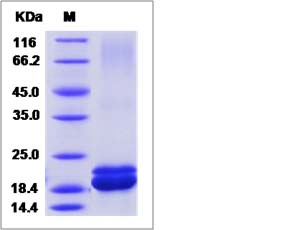Human IFN-alpha / IFNA1 / IFN Protein (His Tag)
IFL,IFN,IFN-ALPHA,IFN-alphaD,IFNA13,IFNA@
- 100ug (NPP3947) Please inquiry
| Catalog Number | P12341-H08Y |
|---|---|
| Organism Species | Human |
| Host | Yeast |
| Synonyms | IFL,IFN,IFN-ALPHA,IFN-alphaD,IFNA13,IFNA@ |
| Molecular Weight | The recombinant human IFNA1 consists of 176 amino acids and predicts a molecular mass of 20.8 kDa. |
| predicted N | Cys 24 |
| SDS-PAGE |  |
| Purity | > (28.7+70.4) % as determined by SDS-PAGE. |
| Protein Construction | A DNA sequence encoding the human IFNA1 (NP_076918.1) (Cys24-Glu189) was expressed with a polyhistidine tag at the C-terminus. |
| Bio-activity | Measured in antiviral assays using WISH cells infected with vesicular stomatitis virus. The ED50 for this effect is 40-200pg/mL. |
| Research Area | Cancer |Invasion microenvironment |Angiogenesis |Cytokine & Receptor |Interferon & Receptor |Interferon | |
| Formulation | Lyophilized from sterile PBS, pH 7.4. 1. Normally 5 % - 8 % trehalose and mannitol are added as protectants before lyophilization. Specific concentrations are included in the hardcopy of COA. |
| Background | IFNA1, also known as IFN-alpha and IFNA, belongs to the alpha/beta interferon family. Interferons(IFNs) are proteins made and released by host cells in response to the presence of pathogens such as viruses, bacteria, parasites or tumor cells. They belong to the large class of glycoproteins known as cytokines. IFNs stimulate the production of two enzymes: a protein kinase and an oligoadenylate synthetase. They allow for communication between cells to trigger the protective defenses of the immune system that eradicate pathogens or tumors. IFNs can activate immune cells, such as natural killer cells and macrophages; they increase recognition of infection or tumor cells by up-regulating antigen presentation to T lymphocytes; and they also increase the ability of uninfected host cells to resist new infection by virus.Leukocyte interferon is produced predominantly by B lymphocytes. Immune interferon is produced by mitogen- or antigen-stimulated T lymphocytes. IFNA1 is produced by macrophages and has antiviral activities. |
| Reference |
